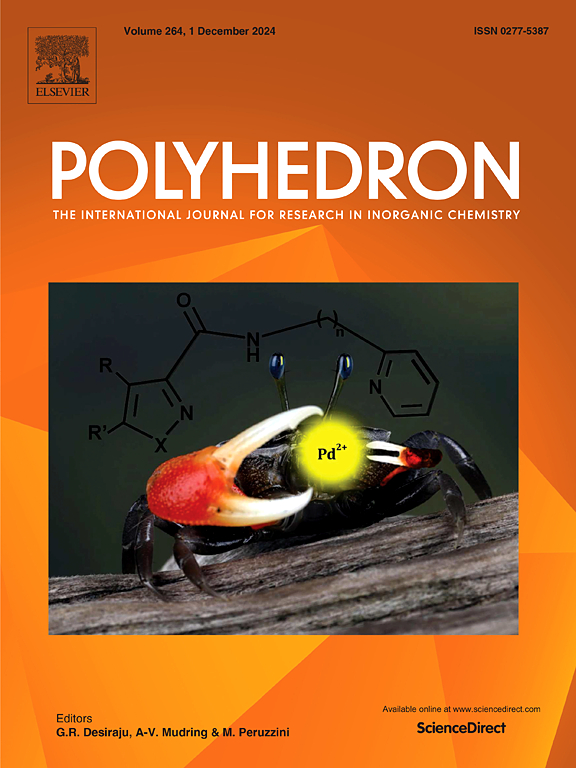利用开心果果皮精油绿色合成氧化铈纳米颗粒及其抗癌性能
IF 2.4
3区 化学
Q2 CHEMISTRY, INORGANIC & NUCLEAR
引用次数: 0
摘要
近年来,研究人员对金属氧化物纳米颗粒在医学上的潜在应用越来越感兴趣。目的以开心果果皮精油(PVEO)为稳定剂合成氧化铈纳米颗粒(CeO2 NPs)。我们还试图评估它们的抗癌特性以及与唑来膦酸对人前列腺癌细胞(LNCap)和乳腺癌细胞(MCF7)的联合作用。方法将硝酸铈溶解于水中,与PVEO结合,制备纳米二氧化硅。将得到的溶液加热并搅拌形成凝胶,随后加热产生CeO2 NPs。利用扫描电子显微镜(SEM)和x射线衍射仪(XRD)对纳米颗粒进行了表征。培养LNCap和MCF7细胞,并用不同浓度的CeO2 NPs和唑来膦酸(ZA)处理。MTT法检测细胞活力,RT-qPCR法检测基因表达。对结果进行统计分析。结果SEM和XRD分析证实了合成的CeO2纳米粒子的尺寸、形状、物相和化学组成。生物实验显示CeO2 NPs对LNCap和MCF7细胞均有显著的细胞毒作用。CeO2 NPs单独或与唑来膦酸联合作用可降低细胞活力,并通过调节细胞凋亡相关基因的表达影响细胞增殖、凋亡和迁移。值得注意的是,PVEO和唑来膦酸的组合对两种癌细胞都有协同作用。结论以开心果果皮精油为原料制备的氧化铈纳米颗粒对前列腺癌和乳腺癌细胞具有明显的细胞毒作用。这些发现表明,pveo衍生的CeO2 NPs可能是治疗这些类型癌症的一种有希望的新方法。本文章由计算机程序翻译,如有差异,请以英文原文为准。

Green synthesis and anti-cancer properties of cerium oxide nanoparticles using pistachio vera pericarp essential oil
Background
In recent years, there has been a growing interest among researchers in the potential applications of metal oxide nanoparticles in medicine.
Objective
This study aims to synthesize cerium oxide nanoparticles (CeO2 NPs) using pistachio vera pericarp essential oil (PVEO) as a stabilizing agent. We also seek to evaluate their anti-cancer properties and the combined effects with zoledronic acid on human prostate cancer cells (LNCap) and breast cancer cells (MCF7).
Methods
CeO2 nanoparticles were synthesized by dissolving cerium nitrate in water and combining it with PVEO. The resulting solution was heated and stirred to form a gel, which was subsequently heated to produce the CeO2 NPs. Characterization of the nanoparticles was conducted using scanning electron microscopy (SEM) and X-ray diffraction (XRD). LNCap and MCF7 cells were cultured and treated with varying concentrations of CeO2 NPs and zoledronic acid (ZA). Cell viability was assessed through the MTT assay, while gene expression was analyzed using reverse transcription quantitative polymerase chain reaction (RT-qPCR). Statistical analysis was performed to interpret the results.
Results
The SEM and XRD analyses confirmed the size, shape, phase, and chemical composition of the synthesized CeO2 NPs. Biological assays revealed significant cytotoxic effects of CeO2 NPs against both LNCap and MCF7 cells. The treatment with CeO2 NPs, either alone or in combination with zoledronic acid, resulted in reduced cell viability and impacted cell proliferation, apoptosis, and migration by modulating the expression of genes associated with apoptosis. Notably, the combination of PVEO and zoledronic acid exhibited a synergistic effect on both cancer cell lines.
Conclusion
The cerium oxide nanoparticles synthesized using pistachio pericarp essential oil demonstrated substantial cytotoxic effects against prostate and breast cancer cells. These findings indicate that PVEO-derived CeO2 NPs may represent a promising new approach for treating these types of cancer.
求助全文
通过发布文献求助,成功后即可免费获取论文全文。
去求助
来源期刊

Polyhedron
化学-晶体学
CiteScore
4.90
自引率
7.70%
发文量
515
审稿时长
2 months
期刊介绍:
Polyhedron publishes original, fundamental, experimental and theoretical work of the highest quality in all the major areas of inorganic chemistry. This includes synthetic chemistry, coordination chemistry, organometallic chemistry, bioinorganic chemistry, and solid-state and materials chemistry.
Papers should be significant pieces of work, and all new compounds must be appropriately characterized. The inclusion of single-crystal X-ray structural data is strongly encouraged, but papers reporting only the X-ray structure determination of a single compound will usually not be considered. Papers on solid-state or materials chemistry will be expected to have a significant molecular chemistry component (such as the synthesis and characterization of the molecular precursors and/or a systematic study of the use of different precursors or reaction conditions) or demonstrate a cutting-edge application (for example inorganic materials for energy applications). Papers dealing only with stability constants are not considered.
 求助内容:
求助内容: 应助结果提醒方式:
应助结果提醒方式:


